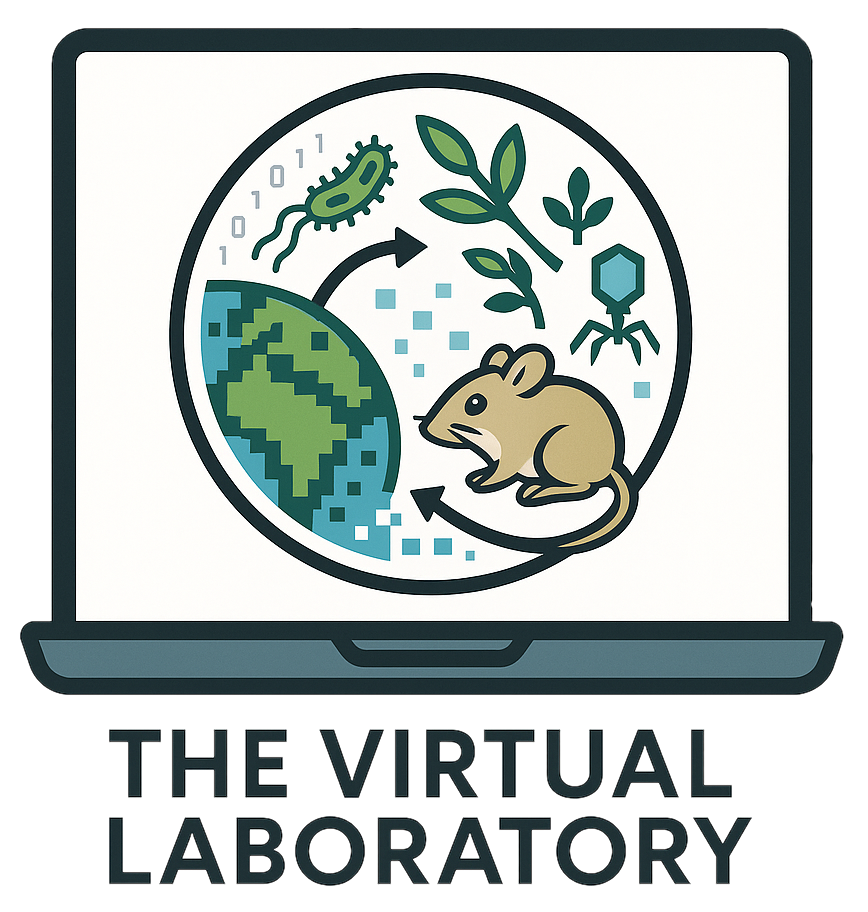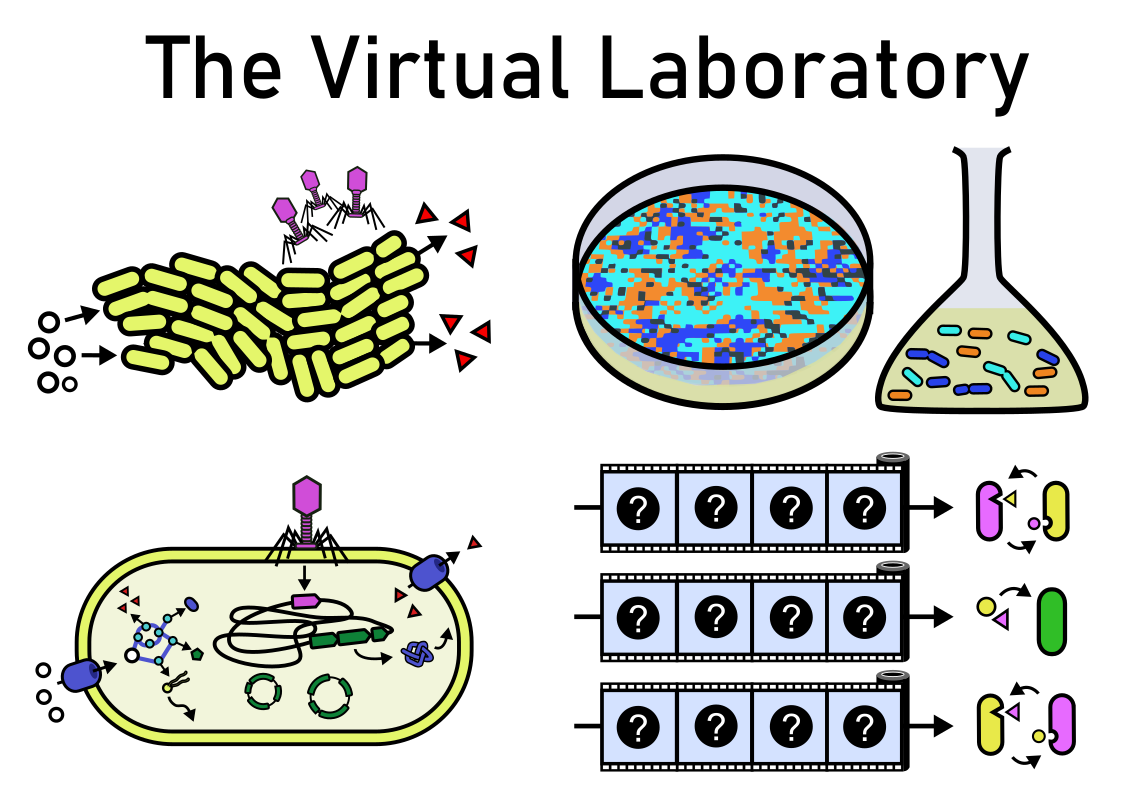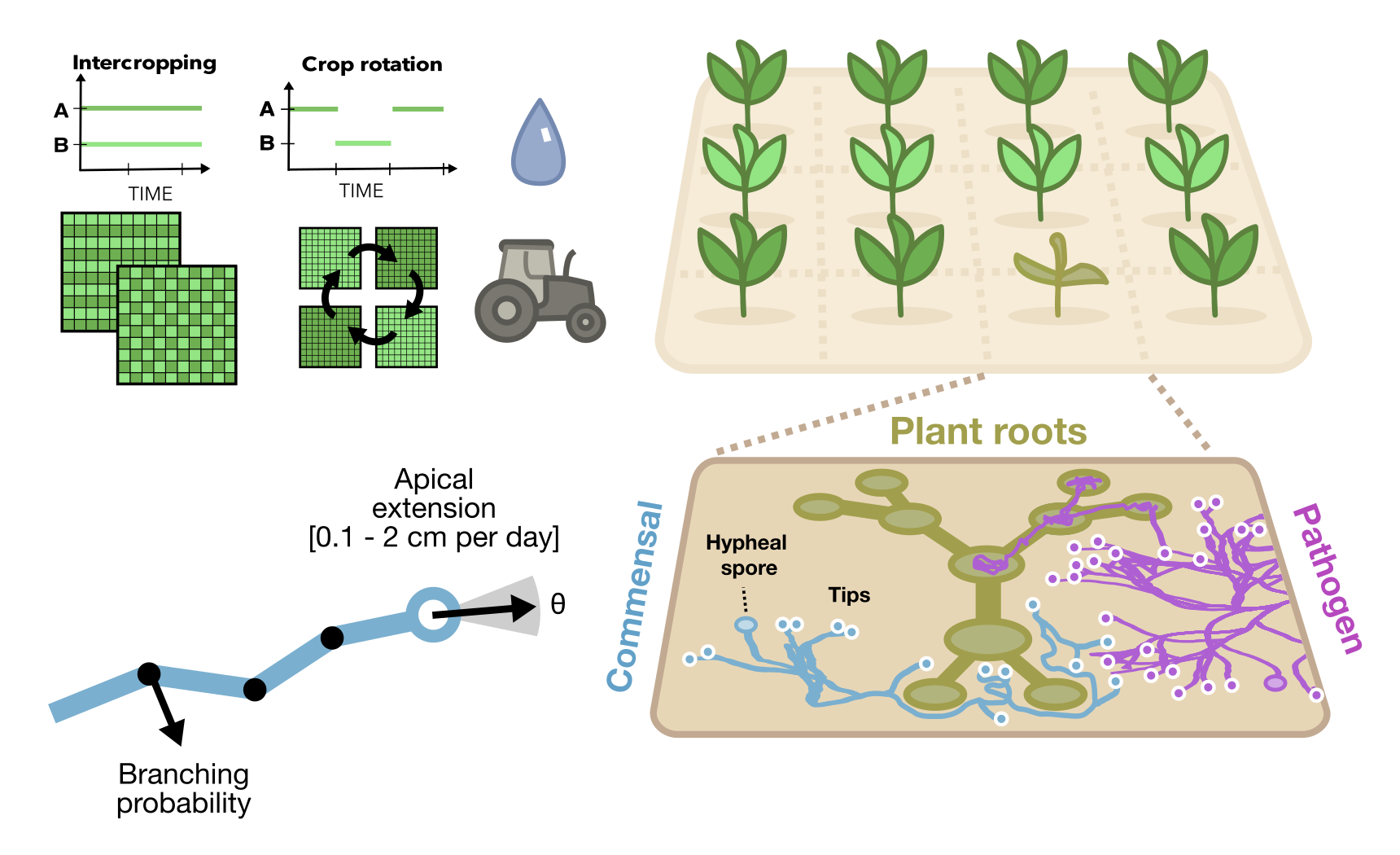The Virtual Laboratory research group

|
Bram van Dijk, with Sultan A. Nazir (PhD candidate)
|
| Home | Education | Google Scholar | Personal website |
Research interests
The Virtual Laboratory research group investigates how biological complexity and genomic patterns emerge from (sometimes surprisingly simple) rules. We focus our scientific energy on simulating complex microbial ecosystems and identifying key principles of their evolution. These models contain many interacting players, such as genes, mobile genetic elements, microbes, and their hosts like plants and animals. We believe that these computational models are integral to understanding the complexity of nature.

Microbial ecology and evolution: a multi-level perspective
Ever since the astonishing diversity of microbial communities was first encountered, these mind-boggling systems have remained a focal point of scientific curiosity. Despite limited current understanding, microbial communities are recognised as indispensable components of life on Earth. They play crucial roles in completing nutrient cycles within terrestrial and aquatic ecosystems and form intricate symbiotic relationships with larger organisms, including plants and animals.
Additionally, the functioning of microbial communities holds direct implications for human well-being, influencing the production of antibiotics, gut and skin health, and interactions with the human immune system. While the study of such complex communities is often facilitated by simplifying them—either through the cultivation of minimal communities in the laboratory or through the use of simplified mathematical models—this reductionist approach may obscure the very processes that emerge from the complexity itself.
Rather than solely relying on simplification, we embrace the complexity of microbial communities, and use it as a productive foundation for investigation. This involves the development of ecological and evolutionary models that incorporate multiple levels of organisation, diverse and potentially conflicting selection pressures, non-trivial genotype-to-phenotype mappings, and the capacity for forming complex interactions. Although the exploration of such models presents substantial challenges, we consider this essential for better comparison with experimental and bioinformatic observations. Only through such interdisciplinary efforts may a deeper understanding of the vast complexity inherent to microbial communities be achieved.
To view an example of what such a multi-level system of ecology and evolution may resemble, see the video below:
Implications for healthy crops, animals, and ecosystems
Microbial evolution is shaped by rapid changes in gene content, often mediated by horizontal gene transfer (HGT). Mobile genetic elements (MGEs) play a central role in this process, moving DNA within and between cells. These elements occupy a continuum between parasitism and mutualism—sometimes benefiting their hosts by carrying useful genes, and other times spreading purely for their own replication. The nature of MGE–host interactions is complex and highly context-dependent.
In fungi, the transfer of genetic information through hyphal networks adds an additional layer of ecological and evolutionary complexity. Such transfers can accelerate the spread of traits like virulence factors, potentially contributing to the emergence of plant and animal pathogens. Yet traits beneficial to the host, such as antimicrobial resistance, are less often associated with these same elements—possibly reflecting the selfish strategies of their propagation.
By building multi-level models of microbial evolution, it becomes possible to explore how MGEs co-evolve with host populations, and how their movement shapes microbial communities, host health, and the stability of ecosystems, particularly in agricultural contexts where such dynamics have pressing consequences.

Modelling horizontal gene transfer: in what sense are bacteria individuals?
Horizontal gene transfer (HGT) is the exchange of genes between two organisms without the necessity of a parent-offspring relationship. While virtually non-existent in complex organisms such as ourselves, HGT is very common in bacteria and other microorganisms. By acquiring genes via HGT, bacteria can rapidly adapt to new ecological opportunities, gaining traits such as antibiotic resistance or novel metabolic capabilities. However, HGT also carries risks. Taking up genes from the environment can expose organisms to selfish genetic elements (SGEs)—genetic parasites that replicate for their own benefit, often at a cost to the host.
Through in silico modelling (i.e. computer simulations of biological systems), I study how HGT affects the spread and maintenance of genes, and how this depends on the fitness effects or functions of these genes. These models help explore when HGT can rescue bacterial populations—for example, by restoring lost functions—and when it leads to catastrophe through the invasion of parasitic elements.
At high rates of gene exchange, HGT also challenges the concept of bacterial individuality and species boundaries. If gene content is continually reshuffled between cells, can a bacterial species still be defined by a stable set of traits? Or does individuality dissolve into a fluid network of shared genes and transient alliances? These are the kinds of questions that computational models can help illuminate, by linking evolutionary outcomes to the underlying mechanics of gene transfer.
Horizontal gene transfer (HGT) is the exchange of genes between two organisms without the necessity of a parent-offspring relationship. While virtually non-existent in complex organisms such as ourselves, HGT is very common for bacteria and other microorganisms. By picking up genes via HGT, bacteria can rapidly adapt to new ecological opportunities. However, HGT also risky. For example, by taking up genes from the environment, organisms expose themselves to genetic parasites called selfish genetic elements (SGEs), which simply try to replicate for their own gain.
Through in silico modelling (i.e. computer simulations of biological systems), I study how HGT affects the spread and maintenance of genes, and how this depends on the fitness effects or functions of these genes. With help of these models, I try to investigate when horizontal gene transfer can come to the rescue of a bacterial population, and when it is nothing less than a catastrophe.
Published insights from the Virtual Laboratory:
- Bacteriophages can help promote the spread of disease in spatially structured systems (https://doi.org/10.1101/2025.02.28.640786)
- Microbial ecosystems are prone do divide labour (e.g. distributing metabolic processes amongst species), impacting stability (https://doi.org/10.1101/2024.07.16.603646 ), and future evolution (https://doi.org/10.1186/s12862-019-1512-2)
- The costly uptake of genes can be adaptive for bacteria, but only for genes that are slightly beneficial (https://doi.org/10.7554/eLife.56801)
- Transposable elements, self-replicating DNA sequences, can promote the evolution of smaller genomes (https://doi.org/10.1101/2021.05.29.446280)
- High levels of population diversity can be maintained when genes for different functions transfer at different rates (https://doi.org/10.1093/gbe/evv255)
Open questions:
- How do different types of interaction structures in microbial ecosystems influence the response to pertubations? Do they buffer or amplify pertubations?
- When do transposable elements become linked to genes with certain ecological functions, such as antimicrobial resistance?
- Can transposable elements persist by relying on host-encoded enzymes in order to jump? (e.g. as appears to be the case for RAYT/REPIN transposases)
- What are the long-term consequences of evolving through HGT (like prokaryotes) and evolving through gene duplications (like eukaryotes)?
Contact
Dr. B. (Bram) van Dijk PhD (he/they)
Hugo R. Kruytgebouw
Padualaan 8
Room N605
3584CH Utrecht
The Netherlands
b.vandijk@uu.nl


